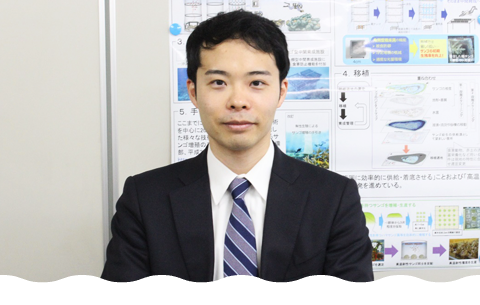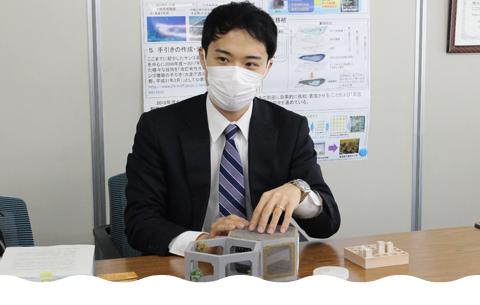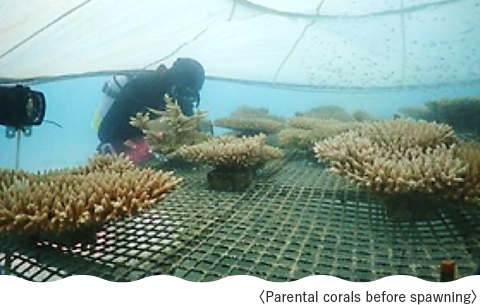
A. I joined the Fisheries Agency in 2016 as an engineering (fisheries civil engineering) staff member. I have secured budgets for public projects related to developing fishing ports and fishing grounds, improved project systems, and revised design standards.
A. I have been in my current position since July 2022. I’m responsible for demonstrating and developing coral propagation technology through sexual reproduction.

A. The department has jurisdiction over infrastructure development related to the fisheries industry. It promotes the development of fishing ports as bases for the fishing industry, fishing grounds to protect and increase fisheries resources, and fishing villages as places for fishing industry workers to live and activation of fishing communities. Our department is developing technologies to increase the number of corals, because coral reefs are essential coastal fields that provide habitats and feeding grounds for fish. In addition to coral reefs, we are also working on conserving and restoring various aquatic environments, such as seaweed beds and tidal flats.


A. Corals belong to the animal phylum Cnidaria, which includes jellyfish and sea anemones. Reef-building corals obtain photosynthetic products from symbiotic zooxanthellae within their bodies. Although photosynthesis occurs inside their bodies, they are classified as animals, not plants.

A. A coral reef is a "landform" created by deposition calcareous sediment, mainly reef-building corals, over a long period. Coral reefs serve a disaster prevention function as natural breakwaters and as a place for various aquatic organisms to spawn, raise young, and provide fodder. However, the frequent occurrence of coral bleaching (the process when coral polyps expel the zooxanthellae living in their tissues and die after an extended period, leaving only its skeleton) due to high water temperatures in recent years have led the reduction the area of coral reefs, and there is concern about the impact on aquatic organisms.

A. A wide variety of corals inhabit Okinotorishima Islands, but it is difficult for coral larvae to enter the island from the surrounding waters naturally. In addition, typhoons significantly impact the island through waves, currents, and gravel movement, making it a harsh environment for coral larvae to settle and grow.
A. We have developed a series of coral propagation technologies, including nursery stock production, mid-term rearing, transplantation, and monitoring. In addition, we have developed technology to expand the area of coral reefs on Okinotorishima Islands based on the transplanted and grown coral communities. There are two methods of producing coral nursery stock: asexual reproduction using partial fragments collected from donor corals; and sexual reproduction using larvae produced by fertilization of eggs and sperm during simultaneous spawning. We are mainly developing sexual reproduction methods. We are also developing technologies to product nursery stock genetically resistant to high temperatures. We have compiled and published our techniques and findings in "A Guidebook for Coral Propagation through Sexual Reproduction."
A. In technological development, we deal with nature, so things do not always go as expected. For example, when we built a device to collect coral larvae and conducted demonstration tests, the device was sometimes damaged by wind and waves. In such cases, we would repair the equipment, consider ways to improve it and reinforce it, giving shape to the technology through repeated trial and error. In other cases, predicting the precise date of coral spawning is challenging, and we have difficulty adjusting when producing nursery stocks and demonstrating in the sea. The coral species we handle on Okinotorishima Islands spawn from late May to June as usual, so we must be able to stay and work there on those days. In addition, the corals we collect and nursery stocks we produce can become sick, so we need to constantly raise them in managing.
A. Although sexual reproduction methods are highly technical, they are superior in producing genetically diverse corals. In addition, it is widely known through the media that corals of the same species in the same area spawn together. Therefore, for example, if corals can be grown to parental colonies in a somewhat dense state, it will be possible to increase the fertilization rate during spawning and supply large quantities of coral larvae to the sea area. We are working on developing technology to make this possible, and we believe that this technology will be effective in restoring and regenerating a wide range of coral reefs.

A. Okinotorishima Islands is a unique field, geographically speaking, having a valuable ecosystem and an essential base for the EEZ. We want everyone to know that various activities, including the efforts of the Fisheries Agency, are being carried out in such a place.